Near our hotel in the Garden District, there are sizeable patches of near-normality in wealthy neighborhoods:
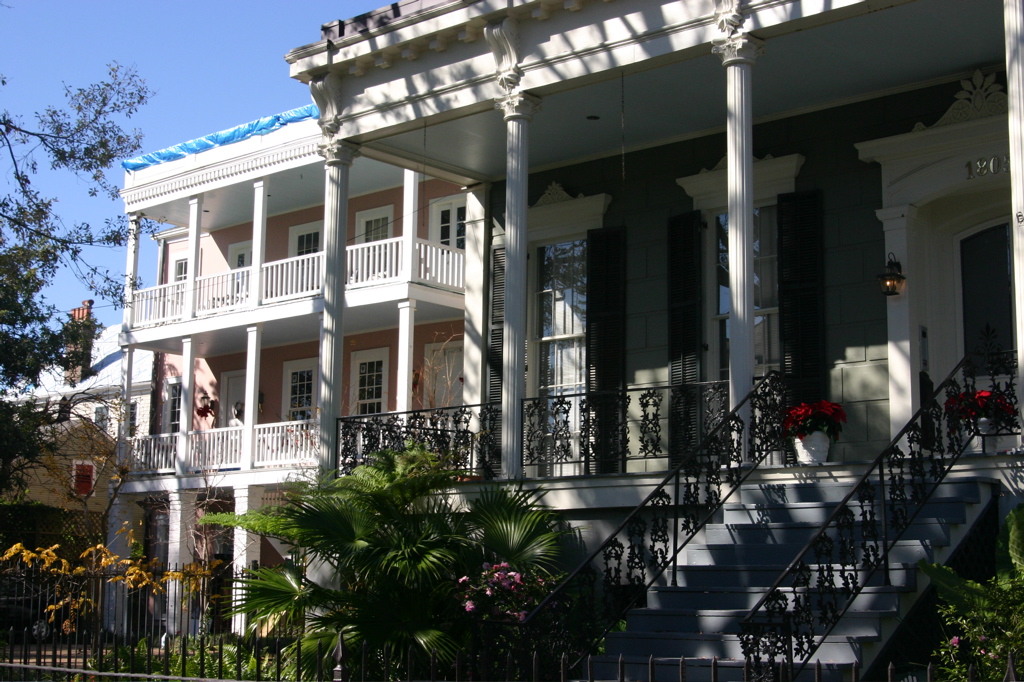
Credit: Zoe Hare
I estimate that around one in two retail businesses are open in the Garden District, central business district, and French Quarter. Here and there, a little holiday cheer has been achieved.
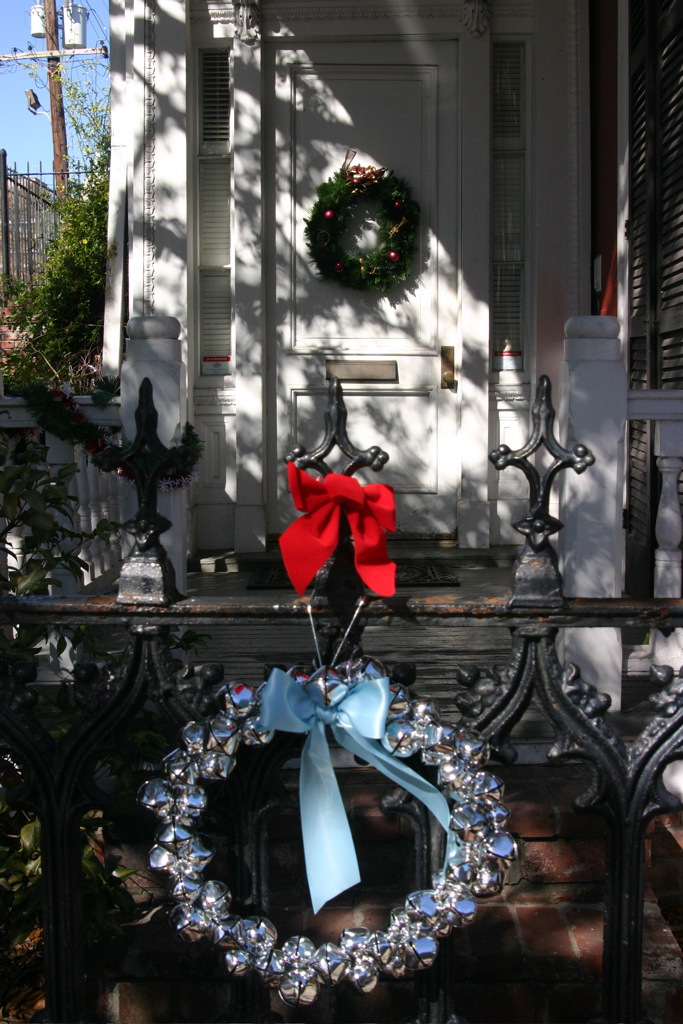
Credit: Zoe Hare
However, only a few blocks away, we started to run into scenes like this:
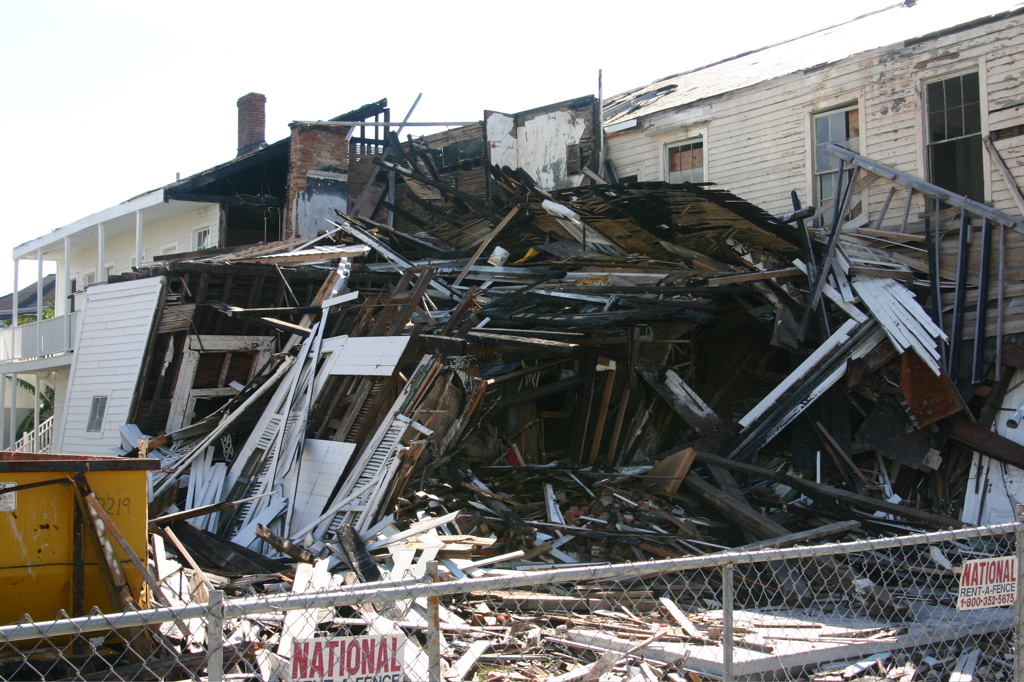
Credit: Zoe Hare
Next to I-10 things got really eerie for a peak-oiler. This abandoned gas station was a powerful metaphor. The spray paint markings are left over from the search for bodies. Note the brown tide marks on the right hand gas pump - the water was only about a foot deep right here. (You can click on the pictures to get a larger version).
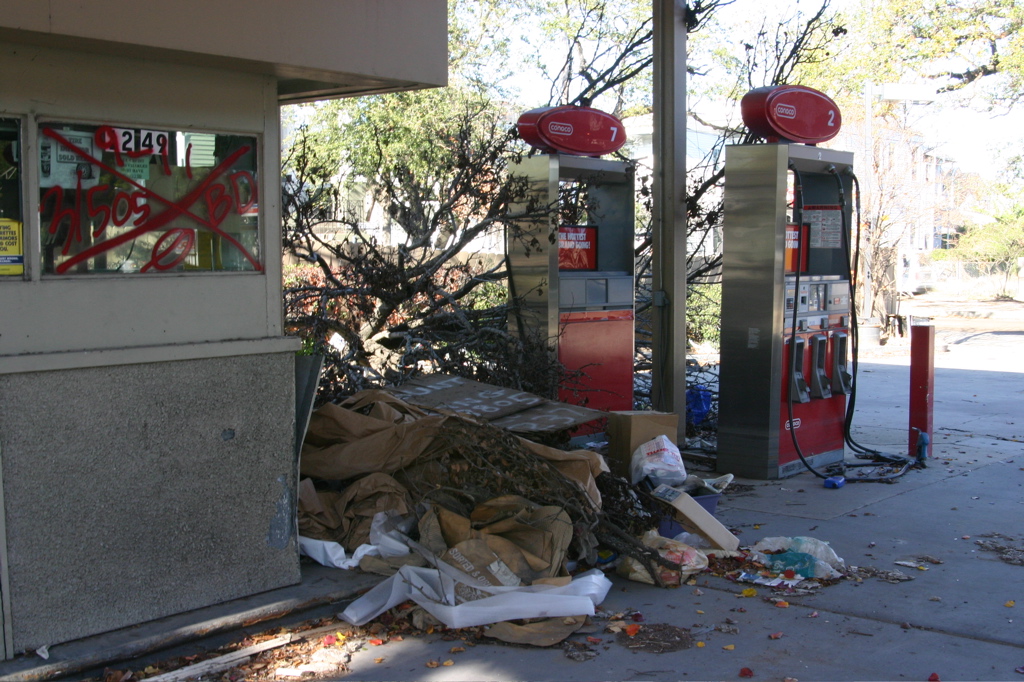
Just across the street, under the freeway, the authorities have been storing abandoned vehicles dragged from out of nearby neighborhoods. The pillars are decorated with murals from before the hurricane. This scene stretches on for block after block after block of ruined vehicles.
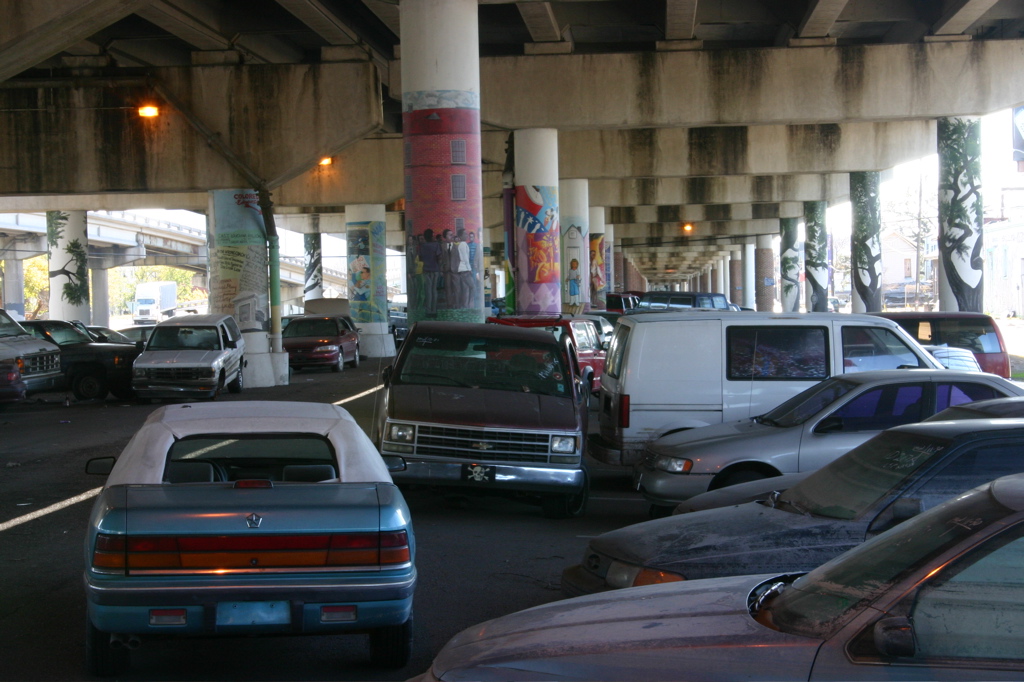
A poignant moment - a child's train through the smashed back window of an SUV evokes a normality that will not return.
As we got into the really hard-hit neighborhoods, it became clear that much of the city is still almost uninhabited. Apparently the population of the city proper has been reduced from about 500,000 to around 100,000. This scene in the 9th Ward is typical. There are blocks and blocks with no-one around and all the vehicles ruined and abandoned. Here and there, a house has life and fresh paint and a clean vehicle.
Credit: Zoe Hare
The National Guard is still here, though mostly a fairly low-key presence. The police are more numerous. We never felt unsafe in any neighborhood, at least by daylight.
Credit: Zoe Hare
The economy is obviously very hard-hit, but in ways that are still confusing to me. On the one hand, every business we went in was operating with a skeleton crew. Hotels and restaurants are often working with 15-30% of the headcount they had before the hurricane and cannot get workers. And yet, here is the scene at the local unemployment office. This line stretched for well over a hundred yards.
Credit: Zoe Hare
Talking with the folks there, it seemed the explanation for at least some people was that they had lost everything, including their identification. They couldn't work without ID, and couldn't afford the fees to get new ID. Many of the people had been made homeless by the hurricane.
My impression overall is that much of New Orleans is not being rebuilt at this point due primarily to political problems - lack of federal action, and local race/class political dynamics (there are people who would like to see the poor neighborhoods redeveloped for a pretty different demographic than lived there before).

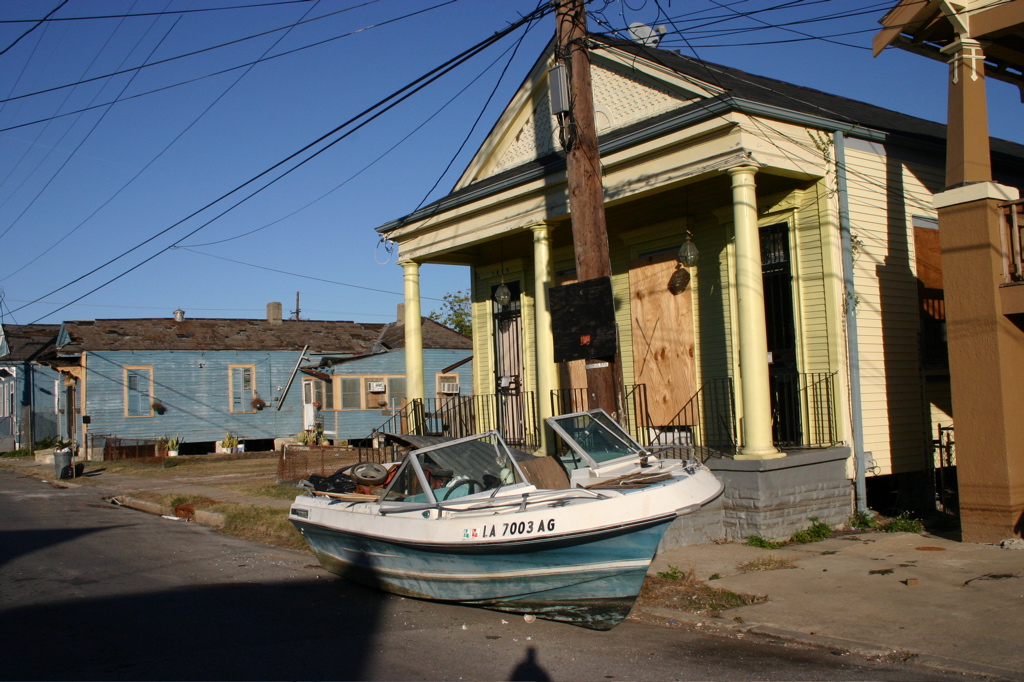
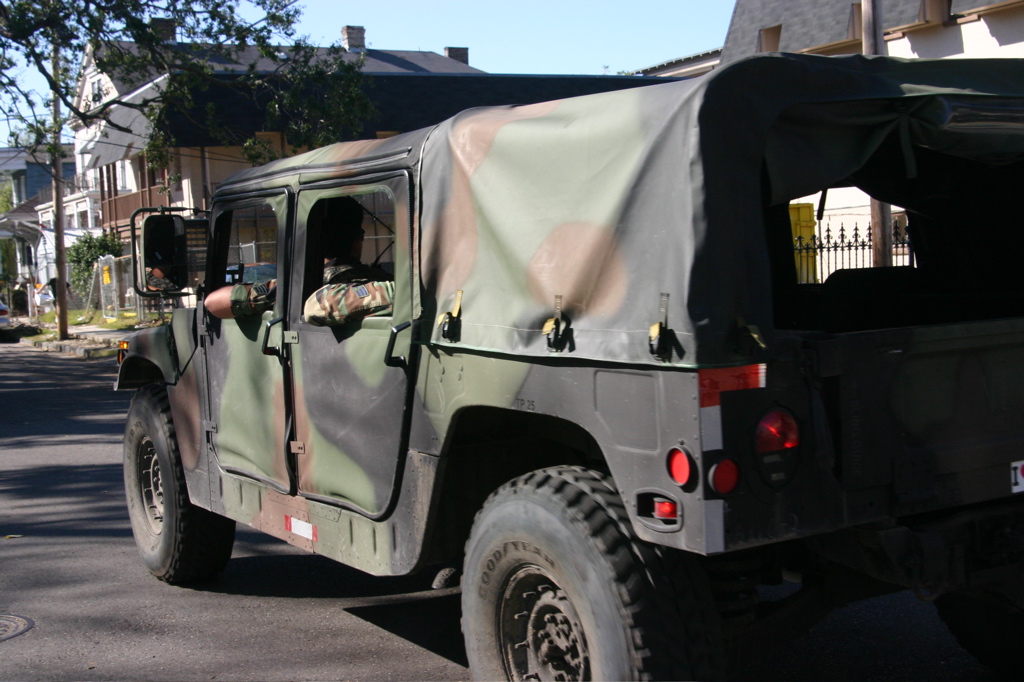
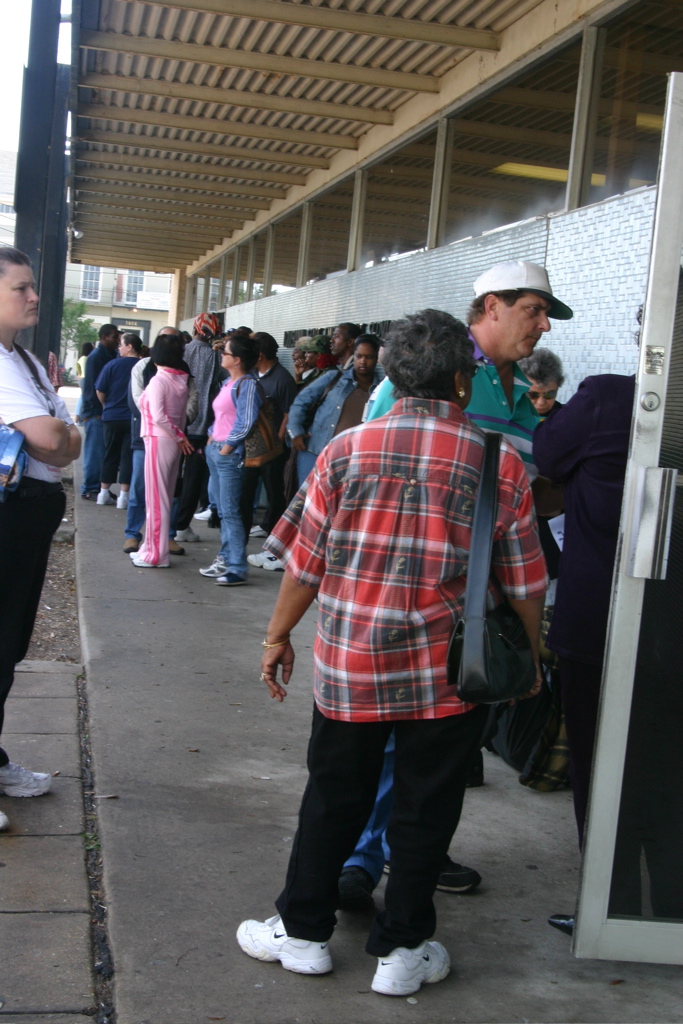




The irony is that these levees destroyed the very wetlands needed to buffer New Orleans and surrounding area from hurricanes. It really doesn't make any sense to "rebuild" New Orleans until these wetlands are restored.
That Bush is the worst president in US history will no doubt become true as time marches on.
For many of us, this is already a fact!
Every time I argue with Republicans today I say one word - Katrina.
No amount of excuses from their lips can ameliorate the bungling of this man.
May God have no mercy on his sole.
Pols should be considered guilty until proven innocent. It doesn't matter what party symbol is beside their name.
Imagine This Was Your Mother - Unbelievable.
From The DailyKos
http://www.dailykos.com/storyonly/2005/12/30/131417/53
http://pesn.com/2005/09/23/9600175_Rebuild_Energy_Systems_Not_NewOrleans/
PureEnergySystems.com > News > Sept. 23, 2005
Infeasibility of Rebuilding New Orleans
The river is moving away from the city. The city is sinking because of its weight, because no upbuilding by new muck for many decades, because of being cut off from the fresh water, because it is sliding off a cliff (the Continental Shelf), and because the Oil and Gas Industry is extracting oil out from under it. It is a city that for all intents and purposes is now Sea domain. Spend the money on developing alternative energy solutions instead.
By Paul Noel and Mary-Sue Haliburton
Pure Energy Systems News - Exclusive
Copyright © 2005
For the full report go to the link above.
As in all disasters, different areas are effected in different ways. In this particular disaster, the "normalcy" that you witnessed along the Garden District and in parts of the French Quarter had less to do with social class than with geography. Simply put, those areas did not flood whereas the majority of the rest of the city did. Of the flooded areas, there were poor districts (like the 9th ward) and wealthy districts, like Lakeview. Poor people were the majority of the population of New Orleans so they will constitute the majority of people effected by the disaster. Previously wealthy families may now consider themselves poor. Many did not carry flood insurance (lenders did not require flood insurance in levee protected areas except for internal flooding) and even those that did can only receive a maximum of 250K which really is not all that much considering total losses.
I do believe that there is a significant parallel between Peak Oil and New Orleans. Nothing serious can be expected to happen without enormous effort because almost nobody is looking out for the common good. Instead of uniting to rebuild the city, the feds, state and local governments are still fighting each other. The local politicians want to preserve their neighborhoods even when resources are simply not sufficient. And individuals want their homes back at little or no cost to themselves. Even when (if) a plan comes together - I'd be that the self-proclaimed losers created by the new plan will go the lawsuit route thus slowing reconstruction even more.
So really what you have is a microcosm of the problems with peak oil, for all the evidence that there is a problem, too many groups stand to lose too much (at least from their point of view) and therefore will use their considerable influence to maintain the status quo. So I believe that it is foolish to ever expect the current administration to embrace peak oil. For each of us, there must be 100, 500, maybe even a thousand more voices telling the administration - don't rock the boat, don't scare investors, the market will sort this out. And unfortunately, those voices probably carry a lot more weight with the administration than we ever will.
On the contrary. If I understand the history correctly, the rich people lived in the Garden District and the French Quarter precisely because they were the higher parts of the city and therefore less susceptible to flooding and disaster.
So we had a situation where the problem was well-known beforehand, and the resources (in a general sense - funding, engineering, management expertise, etc.) which were needed to correct or respond to the crisis were not applied. In my view, this is a sign of institutional "entropy", where major institutions due to complexity and/or political focus, are unable to function to fix the problems we face.
I ran this idea by a friend who is a lawyer, and she said that in her opinion the legal system (in the U.S.) faces a similar form of institutional "entropy" - where the law has gotten so complex that an enormous amount of "legal" energy is wasted pursuing ever small returns.
On a related note, here in California it's being reported that in the Central Valley several local levee districts are going bankrupt. These levees protect farmland and small towns which have a higher value than the cost of repairing the levees.
Yesterday, Slate also ran two interesting articles, one by Witold Rybczynski and another by a local correspondent. Rybczynski makes the point that New Orleans has been losing population for four decades and that Katrina has cruelly and abruptly removed the attachments and bonds of community that have held more people from moving away.
It is sad and frustrating to see what is happening in New Orleans. It is clear that the city will be changed, that it will be smaller and less affordable. People are holding on so tightly to the past, though, that no one can propose how to go forward.
This same paralysis contributed to the damage from Katrina. As reported in the NY Times at the time, several years ago, the U.S. Army Corps of Engineers issued a report that highlighted the danger to New Orleans. In particular, the Corps report illustrated the danger of flooding from Lake Ponchetrain and how there would be little that the city could do once the water got in.
New Orleans had trouble responding to the Corps report, though, because its chief recommendation was that flood walls be created within the city to protect the areas on higher ground: the French Quarter, Canal business district, and the Garden District. Understandably, there was tremendous resistance to the suggestion that a wall be built that would protect the affluent areas at the expense of the poorer neighborhoods.
But, the water did come in. And, because there was no way to respond to the flooding once the water got into the city, the Superdome, hospitals, and other neighborhoods flooded that could have been protected by the proposed flood wall.
It is tragic that the poorer citizens of New Orleans were impacted the most by Katrina and that the city will wind up losing so much of its affordable housing base. But really, is New Orleans that different than any other city or community in the U.S., or in most places. The poor tend to live in marginal areas - areas at risk from flooding and other natural disasters as well as diseases. In many cases, the poor live there because these areas are more affordable because the affluent can afford to live in neighborhoods with good drainage.
New Orleans is going to have to decide how to prepare for the next storm. Unfortunatley, building bigger and stronger levees to protect the city from a Category 5 storm (Katrina was a Cat. 3 at landfall) will take too long and be prohibitively expensive. The levees can be improved to withstand a Cat. 4 storm, though. However, the city will also need to decide how to minimize and mitigate potential damage should the water get in again. There are ways to do this, but it means taking the land where people's houses used to stand, and it will mean building houses above an anticipated flood level. A practice that is common on other areas of the Gulf Coast, but one that will change the physical character of the city, as well as an idea that is vehemently resisted by New Orleans' eldery residents.
The residents of New Orleans and the citizens of Louisiana are going to have to make some tough decisions. Waiting isn't going to make the decisions any easier.
While I was there (1971-1979), we had hurricanes but nothing like Katrina. Even so, one of them flooded our house. Another storm moved someone else's house to the middle of the highway. We would often evacuate to somewhere "up the bayou."
As I browsed in a bookstore the other day, I picked up a book called "Bayou Farewell" by Mike Tidwell, which describes the author's trips down the various bayous to find out about cajun life. I haven't read the whole book yet, but my understanding is that the book turned out to be different than the one he intended to write.
What he discovered as he hitchhiked down the bayous (Bayou Lafourche, Bayou Petite Calliou, and Bayou Grand Calliou) is that the land is disappearing into the Gulf of Mexico because of the levees on the Mississippi keeping new sediments from being deposited and because of erosion caused by all the oil and gas canals cut through the marsh.
Last night I played with Google Earth a little bit and looked at the satellite photos of the Chauvin, Lake Boudreaux, and the surrounding marsh and saw that it's really true. There's much more water now than when I was fishing and hunting and trawling there.
Also, the Gulf used to be quite a boat road through the marsh once you left Cocodrie, where the road ends. Now, the Gulf is almost upon that little launching point. As bad as Little Calliou is, though, Bayou Lafourche is worse. From Golden Meadow all the way to Grand Isle, the land is almost completely gone.
Looking at the Google Earth photos is very eery too because you can see the patchwork of canals, many of them overlapping. Because of the rising water/sinking land, they're almost like ghosts, though.
Since I grew up down there, I know the places that the book is talking about and can see the changes from the photos. I haven't been down there since 1986, but now I'd like to go see how much worse it is because of the hurricanes. Katrina didn't hit Chauvin hard, but Rita did.
I had spent some time on a business trip, cicra 1971, to Patterson and Morgan City. Having been a kid originally from New Jersey, spending some time on the bayou was a real eye-opener .... for me it might as well have been a different planet. I felt like an alien, but I really liked it down there.
It's really tragic how we're slowly losing some of the more 'exotic' places in this country. I just fear that the rebuilt (if it ever is) New Orleans will be but a Disney theme park version of the real thing.
And, yes, the country there--the marshes, bayous, lakes, and wildlife--was really important to me. I spent countless hours paddling pirogues in the back bayous, trudging through the marshes, and trawling for shrimp. It was my escape.
As you recognized in your visit to cajun country, it's not like the rest of the country. I went through extreme culture shock when I moved there as a ten year old outsider boy with a redneck accent and a name that stood out (in more ways than one).
Anyway, it is tragic how much of that land is being lost. I read today that about 50 acres a day is sinking beneath the water. And, even though Stuart's post isn't directly PO related, it is oil-related because the oil (and gas) drilling companies have exacerbated the loss with all their canals. That loss of land reduced the buffer that would have given New Orleans more protection from Katrina.
In fact, without restoring the marshland and barrier islands, rebuilding NO will be worse than futile. It will be criminal because more people will die and more property will be destroyed, and each year the damage will get worse. I don't think even a Disneyfied NO will be sustainable.
This article by the author of the book I mentioned above has more info about rebuilding NO without rebuilding the buffer:
http://www.truthout.org/docs_2005/120705O.shtml
Three Katrina Evacuees Found Dead in Texas
Dec 31, 2005 : 12:21 am ET
GRAPEVINE, Texas -- A family of three Hurricane Katrina evacuees facing eviction was found dead Friday in their Texas apartment in what appears to be a double murder-suicide, authorities said.
Police were called by the apartment complex to assist in the eviction and discovered the bodies, said police Sgt. Todd Dearing in Grapevine, near Dallas.
Found with gunshot wounds were a 40-year-old man, a 37-year-old woman and a 14-year-old boy, all from Louisiana. Police found a shotgun believed to be the weapon, Dearing said.
Police were searching for a 16-year-old daughter they believe was living elsewhere, he said. Names were being withheld until relatives could be notified.
A resident told the complex Thursday of hearing what sounded like three gunshots near the victims' apartment, Dearing said. Police were called but left when no one answered the door.
Snip ......
http://www.heraldsun.com/firstnews/37-684451.html